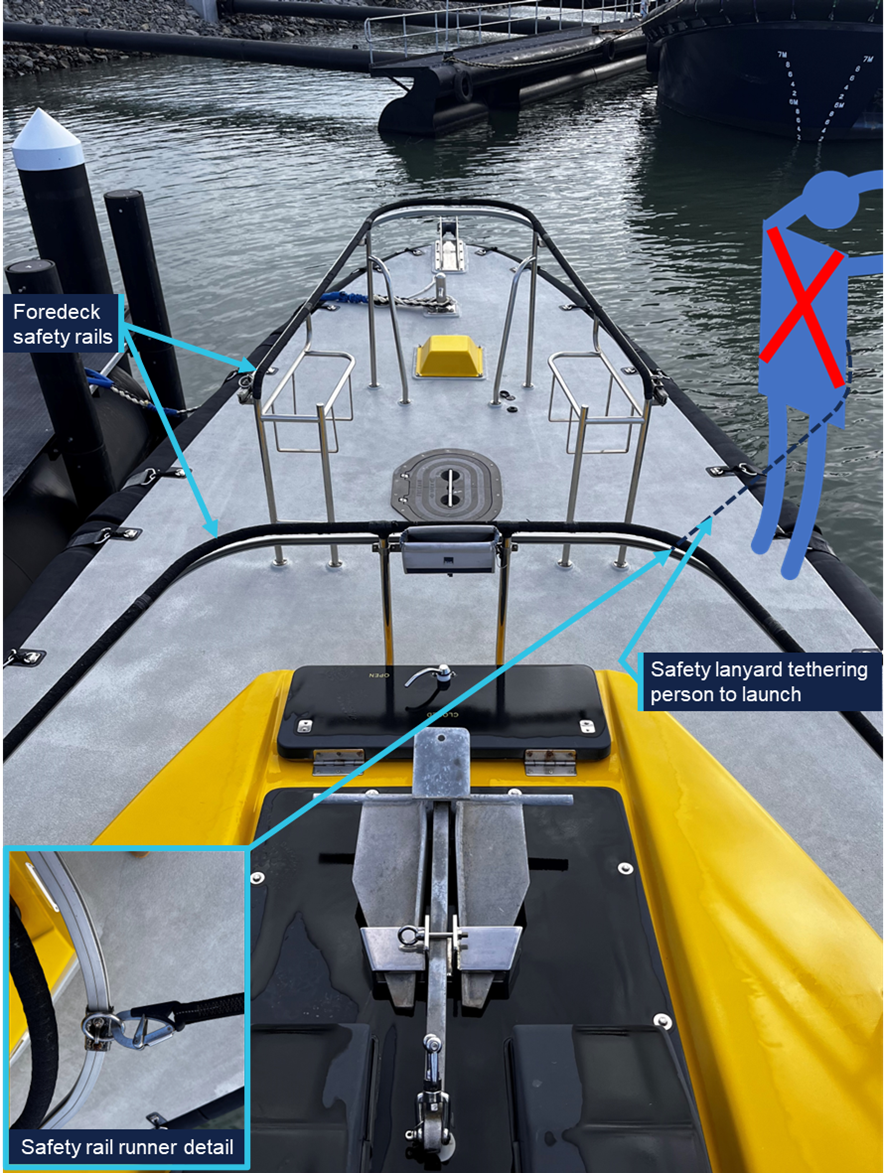What happened
At 0800 local time on 25 May 2025, the deckhand of a marine pilot transfer vessel (pilot launch) was seriously injured during pilot transfer operations off Devonport, Tasmania. The incident occurred at the pilot boarding ground while the 16 m pilot launch was alongside a 183 m tanker, preparing to transfer 2 marine pilots to the ship for its entry to the port.
The pilot launch had departed the port at about 0715 with 2 crewmembers (launch master and deckhand) and 2 pilots (one was undertaking training) on board. During the transit to the pilot boarding ground, the launch master noted winds of 10 to 15 knots and a swell of 1.5 to 2 m, both from the north‑west. As the launch approached the lee side of the ship, those on board assessed the conditions and agreed to proceed with the transfer.
Once alongside, starboard side to the ship, the deckhand and both pilots left the launch wheelhouse and moved to the foredeck. Conditions in the lee of the ship were rougher than had been experienced during the recent months, and they waited for the launch’s motion to become more favourable. All 3 were tethered to the launch safety rail with individual lanyards.
After informing the pilot in charge, the deckhand, in accordance with company pilot transfer procedures, went forward to inspect the ship’s pilot ladder. The deckhand noted that the ladder was new and then took hold of it with both hands and stepped onto it to check if it was securely rigged (Figure 1). While the deckhand was on the ladder, the launch fell away into the trough of a passing wave. The deckhand was pulled by the lanyard, off the pilot ladder and onto the foredeck of the launch, resulting in serious injuries. The 2 pilots (who had not seen the approaching wave) quickly rendered assistance to the deckhand.
Shortly after, the launch master manoeuvred it clear of the ship and contacted Devonport vessel traffic service (VTS), requesting medical assistance. The pilot transfer was suspended and the launch returned to port where the deckhand was transferred ashore and taken to hospital.
Figure 1: Pilot launch foredeck with crewmember position to test the pilot ladder shown

Source: TasPorts, annotated by the ATSB
Pilot transfer
All vessels of 35 m or more (length overall) calling at Tasmanian ports must engage a licenced marine pilot (unless the master holds a pilotage exemption for that area) and must participate in the VTS.
In compliance with the harbour master’s instructions, arriving ships’ masters were to complete a ‘VTS – Pre Arrival form’ which included acknowledgement that the pilot ladder checklist had been read, understood and submitted at least 72 hours prior to the planned pilotage.
The comprehensive checklist stated that the master was responsible for ensuring that the pilot ladder had been stored and maintained in good condition, was regularly inspected, was certified by the manufacturer of the ladder and complied with the SOLAS requirements.[1] Among the items on the checklist, was whether the pilot ladder had been properly secured to a strongpoint on the ship’s deck. The checklist was accompanied by a copy of the IMO / IMPA ‘Required boarding arrangements for pilot’ poster.[2]
In addition to requirements of and assurances from the arriving ship’s master, the pilotage provider also had a ‘Pilot vessel—pilot transfer procedure’ applicable to its operations across 10 ports. This procedure detailed that the master of the pilot launch was responsible for the safety of all persons on board the pilot launch while it was underway. The pilot (in charge) on board was responsible for the final assessment of the suitability for the transfer to continue.
Any person not inside the launch cabin enclosed area was required to be tethered with a safety lanyard to the lanyard rail. The procedure also required the deckhand to assess/check the pilot ladder condition and if it was properly rigged. These checks routinely included checking if the ladder was secure by grasping the ladder with both hands and stepping one foot onto the ladder. This check was the common method used in this port and across other ports in Tasmania and other jurisdictions. This check was conducted on all ladders regardless of their apparent age.
Safety action
The pilotage provider completed an internal investigation which found, among other things, that there were no swell parameters for Devonport pilot boarding ground transfers. Wind conditions, for which parameters existed, were well within limits during this transfer. The statements of those involved indicated that the conditions in the ship’s lee had not been experienced for several months but were not sufficiently adverse to not proceed with the transfer. However, as the motion of the launch subsided and the deckhand went forward to test the ladder, the pilots did not note the approaching wave trough and were unable to warn the deckhand.
As part of the internal investigation, a DMAIC (define, measure, analyse, improve, control) process was completed. The process identified several areas for improvement, including:
- pilot transfer and pilot ladder testing methods and arrangements including review of practices in other ports
- safety equipment including safety harness and lanyard use during pilot transfer
- weather monitoring equipment and arrangements
- the use of personnel and resources, rostering and training, including safety preparedness and response.
Following the investigation, the pilotage provider released a memorandum which outlined mandatory interim safety controls to be implemented across all pilot transfer operations. The new safety controls required that, prior to commencing the transfer, the launch master was to contact the ship and confirm that the pilot ladder had been rigged as per SOLAS requirements and that the arrangement had been tested. Further, any manual test by the launch crew was to be conducted using arms only while ensuring the tester’s body remained fully on the pilot launch’s deck.
A review of the safety lanyards in use has led to the implementation of a shorter lanyard which prevents the crewmember from shifting their weight fully onto the pilot ladder (external of the pilot launch). The memo also emphasised that the transfer was to be stopped should any doubt arise.
Safety message
Pilot transfer operations continue to be a high‑risk operation. This occurrence highlights that the risks also include preparations for the transfer involving other crew members along with the marine pilots.
All persons involved in pilot transfer and transport need to be aware of risks involved in this operation. All should pay particular attention to the sea and to the motion it imparts to the pilot launch and the subsequent effects on the actions being undertaken at the time. The pilot launch is a small vessel alongside a much larger and more stable vessel. Transferring from the deck of the launch to the pilot ladder attached to the ship exposes personnel to the risks posed by the relative motion between the 2 vessels, especially if they remain attached to the launch.
About this report
Decisions regarding whether to conduct an investigation, and the scope of an investigation, are based on many factors, including the level of safety benefit likely to be obtained from an investigation. For this occurrence, no investigation has been conducted and the ATSB did not verify the accuracy of the information. A brief description has been written using information supplied in the notification and any follow-up information in order to produce a short summary report, and allow for greater industry awareness of potential safety issues and possible safety actions.
[1] SOLAS CH V- Regulation 23 - Pilot Transfer Arrangements Resolution A.1045 (27)
[2] The International Maritime Pilots’ Association (IMPA) produced an industry reference poster outlining the SOLAS requirements pilot transfer arrangements. IMPA is the international non-governmental organization in consultative status representing maritime pilotage at the IMO. (www.impahq.org)


